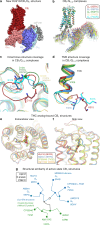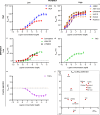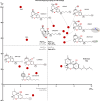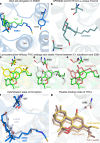Structural basis of THC analog activity at the Cannabinoid 1 receptor
- PMID: 39779700
- PMCID: PMC11711184
- DOI: 10.1038/s41467-024-55808-4
Structural basis of THC analog activity at the Cannabinoid 1 receptor
Abstract
Tetrahydrocannabinol (THC) is the principal psychoactive compound derived from the cannabis plant Cannabis sativa and approved for emetic conditions, appetite stimulation and sleep apnea relief. THC's psychoactive actions are mediated primarily by the cannabinoid receptor CB1. Here, we determine the cryo-EM structure of HU210, a THC analog and widely used tool compound, bound to CB1 and its primary transducer, Gi1. We leverage this structure for docking and 1000 ns molecular dynamics simulations of THC and 10 structural analogs delineating their spatiotemporal interactions at the molecular level. Furthermore, we pharmacologically profile their recruitment of Gi and β-arrestins and reversibility of binding from an active complex. By combining detailed CB1 structural information with molecular models and signaling data we uncover the differential spatiotemporal interactions these ligands make to receptors governing potency, efficacy, bias and kinetics. This may help explain the actions of abused substances, advance fundamental receptor activation studies and design better medicines.
© 2025. The Author(s).
Conflict of interest statement
Competing interests: D.E.G. is a part-time employee and warrant-holder at Kvantify. D.A.S and D.B.V. are both founders and directors of Z7 Biotech Ltd, an early-stage drug discovery CRO. The remaining authors declare that the research was conducted in the absence of any commercial or financial relationships that could be construed as a potential conflict of interest.
Figures






Update of
-
Structural basis of Δ9-THC analog activity at the Cannabinoid 1 receptor.Res Sq [Preprint]. 2024 May 21:rs.3.rs-4277209. doi: 10.21203/rs.3.rs-4277209/v1. Res Sq. 2024. Update in: Nat Commun. 2025 Jan 8;16(1):486. doi: 10.1038/s41467-024-55808-4. PMID: 38826401 Free PMC article. Updated. Preprint.
Similar articles
-
Structural basis of Δ9-THC analog activity at the Cannabinoid 1 receptor.Res Sq [Preprint]. 2024 May 21:rs.3.rs-4277209. doi: 10.21203/rs.3.rs-4277209/v1. Res Sq. 2024. Update in: Nat Commun. 2025 Jan 8;16(1):486. doi: 10.1038/s41467-024-55808-4. PMID: 38826401 Free PMC article. Updated. Preprint.
-
Structure-based identification of a G protein-biased allosteric modulator of cannabinoid receptor CB1.Proc Natl Acad Sci U S A. 2024 Jun 11;121(24):e2321532121. doi: 10.1073/pnas.2321532121. Epub 2024 Jun 3. Proc Natl Acad Sci U S A. 2024. PMID: 38830102 Free PMC article.
-
Identification of essential cannabinoid-binding domains: structural insights into early dynamic events in receptor activation.J Biol Chem. 2011 Sep 23;286(38):33422-35. doi: 10.1074/jbc.M111.261651. Epub 2011 Jul 27. J Biol Chem. 2011. PMID: 21795705 Free PMC article.
-
Dissecting the cannabinergic control of behavior: The where matters.Bioessays. 2015 Nov;37(11):1215-25. doi: 10.1002/bies.201500046. Epub 2015 Aug 11. Bioessays. 2015. PMID: 26260530 Review.
-
Molecular Pharmacology of Synthetic Cannabinoids: Delineating CB1 Receptor-Mediated Cell Signaling.Int J Mol Sci. 2020 Aug 25;21(17):6115. doi: 10.3390/ijms21176115. Int J Mol Sci. 2020. PMID: 32854313 Free PMC article. Review.
Cited by
-
Extraction of Cannabinoids and Terpenes from Hemp Flowers and Leaves (Cannabis sativa L., Futura 75): Chemical Profiling and Evaluation of Anticancer Properties.Molecules. 2025 Mar 15;30(6):1325. doi: 10.3390/molecules30061325. Molecules. 2025. PMID: 40142100 Free PMC article.
-
Biased Signaling and Its Role in the Genesis of Short- and Long-Acting β2-Adrenoceptor Agonists.Biochemistry. 2025 Aug 19;64(16):3585-3598. doi: 10.1021/acs.biochem.5c00148. Epub 2025 Aug 7. Biochemistry. 2025. PMID: 40773134 Free PMC article.
-
How THC works: Explaining ligand affinity for, and partial agonism of, cannabinoid receptor 1.iScience. 2025 May 21;28(7):112706. doi: 10.1016/j.isci.2025.112706. eCollection 2025 Jul 18. iScience. 2025. PMID: 40687805 Free PMC article.
References
-
- Schutz, S. G., Dunn, A., Braley, T. J., Pitt, B. & Shelgikar, A. V. New frontiers in pharmacologic obstructive sleep apnea treatment: a narrative review. Sleep. Med. Rev.57, 101473 (2021). - PubMed
-
- Nielsen, S. et al. The use of cannabis and cannabinoids in treating symptoms of multiple sclerosis: a systematic review of reviews. Curr. Neurol. Neurosci. Rep.18, 8 (2018). - PubMed
MeSH terms
Substances
Grants and funding
LinkOut - more resources
Full Text Sources
Miscellaneous

